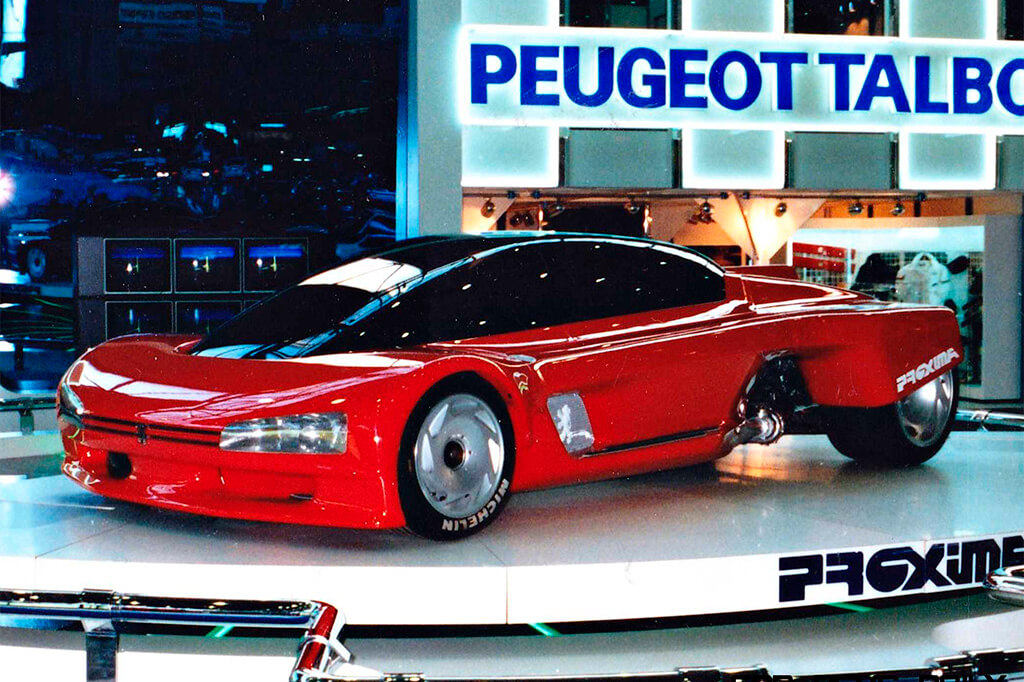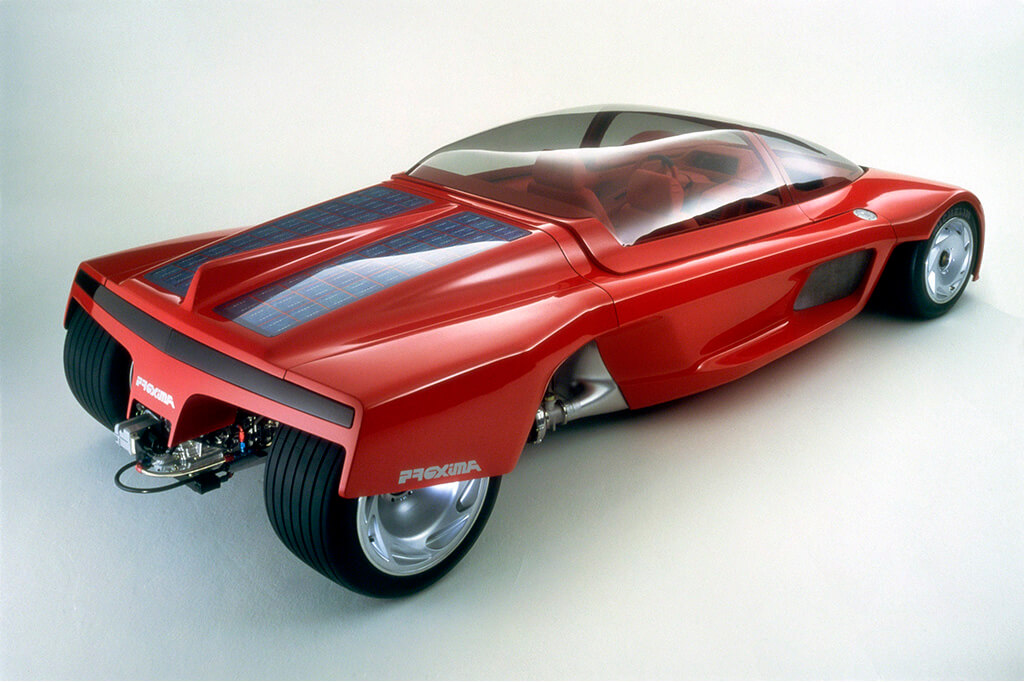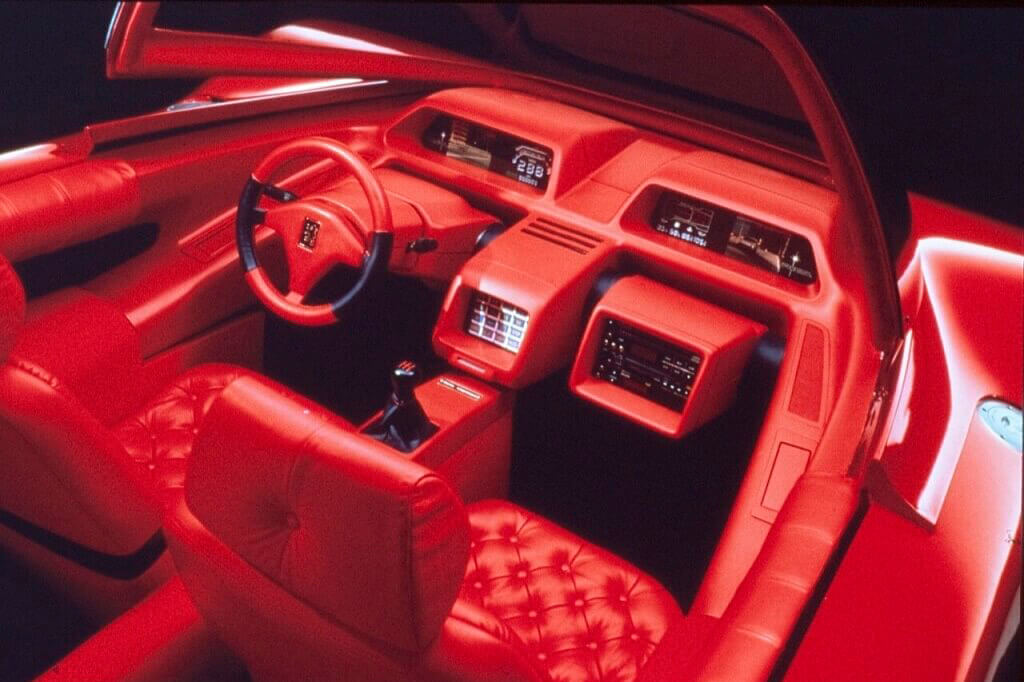Peugeot Proxima Concept
Description
The Peugeot Proxima is a 2+2 concept car created by the Peugeot Style Center, inspired by the work of designer Luigi Colani, and presented at the 1986 Paris Motor Show. It replaced the 1984 Peugeot Quasar (the manufacturer's first prototype) and preceded the 1988 Peugeot Oxia and the 1990 Peugeot 905. Inspired by space exploration, science fiction and avant-garde technology of the 1980s, it is named after the star Proxima Centauri, closest to the Sun.
The power unit is located in the center, a 24-valve V-shaped six-cylinder engine with a displacement of 2.8 liters, equipped with turbocharging (with two turbochargers and intercooling of air), developed 680 horsepower.
The transmission is all-wheel drive with an automatically engaged front axle; torque is distributed electronically between the axles. By default, traction was supplied to the rear axle, but if necessary, the front axle was instantly connected.
The concept was equipped with overheat-resistant carbon ventilated brake discs with ABS. The tires were equipped with an automatic pressure control and maintenance system. The suspension consisted of front and rear double A-arms derived from successful modeling analysis used to create the 205 GTI and 205 Turbo 16 models.
The unusually shaped body was made of carbon fiber (weight was only 1080 kg), without the usual doors, and a large sliding polycarbonate roof was used for entry and exit.
The interior of the concept was designed in an avant-garde manner, had anatomical seats, as well as displays that replaced control instruments. The Peugeot Proxima did not have a dashboard - instead there were five color LCD screens in the cabin. Two on-board computers that controlled various systems of the machine had quite extensive memory for their time – 40 megabytes. The concept also had one of the first prototypes of a satellite navigation system (GPS), five cameras, and a collision avoidance radar.
Additional features include an electronic key card for starting the engine and a solar-powered interior ventilation system thanks to photovoltaic cells located above the rear panel of the engine cover.
Sources
Specification
| Bodywork | |
|---|---|
| Presentation | |
| Years of production |
1986
|
| Produced (pcs.) |
1
|
| Body type |
купе
|
| Number of doors |
1
|
| Number of places |
2+2
|
| Engine | |
|---|---|
| Engine type |
бензиновый
|
| Engine location |
центральное, продольное
|
| Engine model |
PRV (PSA ZN/Renault Z7W)
|
| Cylinders |
V6
|
| V-angle |
90°
|
| Cylinder operation |
1-6-3-5-2-4
|
| Capacity (cc) |
2849
|
| Power output (hp / kW /) |
601 /
442 /
|
| at rpm |
8000
|
| Torque (N·m) |
608
|
| at rpm |
6000
|
| Bore (mm) |
91,0
|
| Stroke (mm) |
73,0
|
| Compression |
8,6
|
| Number of valves |
4/24
|
| Valvetrain |
SOHC
|
| Block material |
алюминиевый сплав
|
| Engine weight (kg) |
150
|
| Fuel system |
впрыск
|
| Turbocharger |
2
|
| Specific | |
|---|---|
| Specific output (hp/litre) |
210,95
|
| Specific output (hp/tonne) |
556,48
|
| Specific output (kg/hp) |
1,80
|
| Specific torque (N·m/litre) |
213,41
|
| Specific torque (N·m/tonne) |
562,96
|
| Transmission | |
|---|---|
| Driven wheels |
полный
|
| Gearbox |
механическая
|
| Number of speeds |
5
|
| Suspension | |
|---|---|
| Front suspension |
независимая
|
| Rear suspension |
независимая
|
| Elastic elements in front |
пружины
|
| Elastic elements in rear |
пружины
|
| Tire brand |
Michelin
|
| Steering | |
|---|---|
| Steering type |
шестерня-рейка
|
| Brakes specs | |
|---|---|
| Brakes front |
дисковые вентилируемые
|
| Brakes rear |
дисковые вентилируемые
|
| Disc material |
карбон-керамика
|
| Anti-lock braking system |
да
|
| Dimensions and weight | |
|---|---|
| Body |
стальной трубчатый каркас
|
| Body material |
углеволокно
|
| Length (mm) |
4420
|
| Width (mm) |
2110
|
| Height (mm) |
1140
|
| Wheelbase (mm) |
2750
|
| Curb weight (kg) |
1080
|
| Performance specs | |
|---|---|
| Fuel type |
Аи-95
|
| Top speed (kph) |
300
|
|---|---|
| Top speed (mph) |
186
|
| Tags: | |
|---|---|
| Type: | |
| Brand: | |
| Country: |



